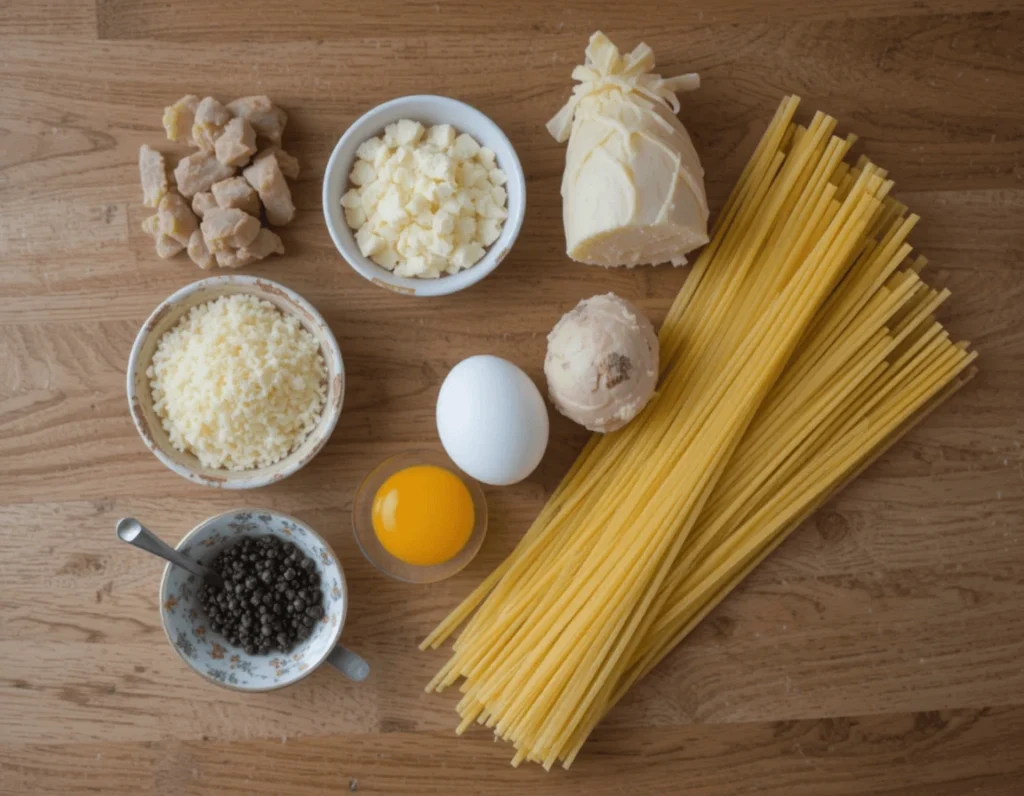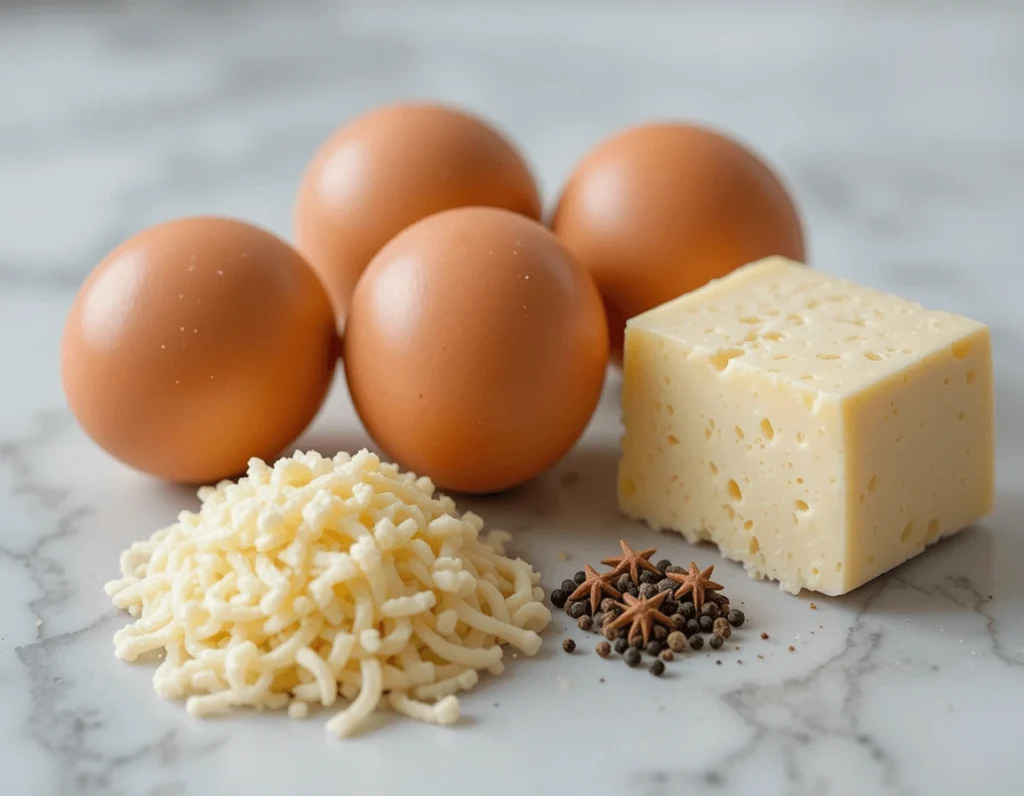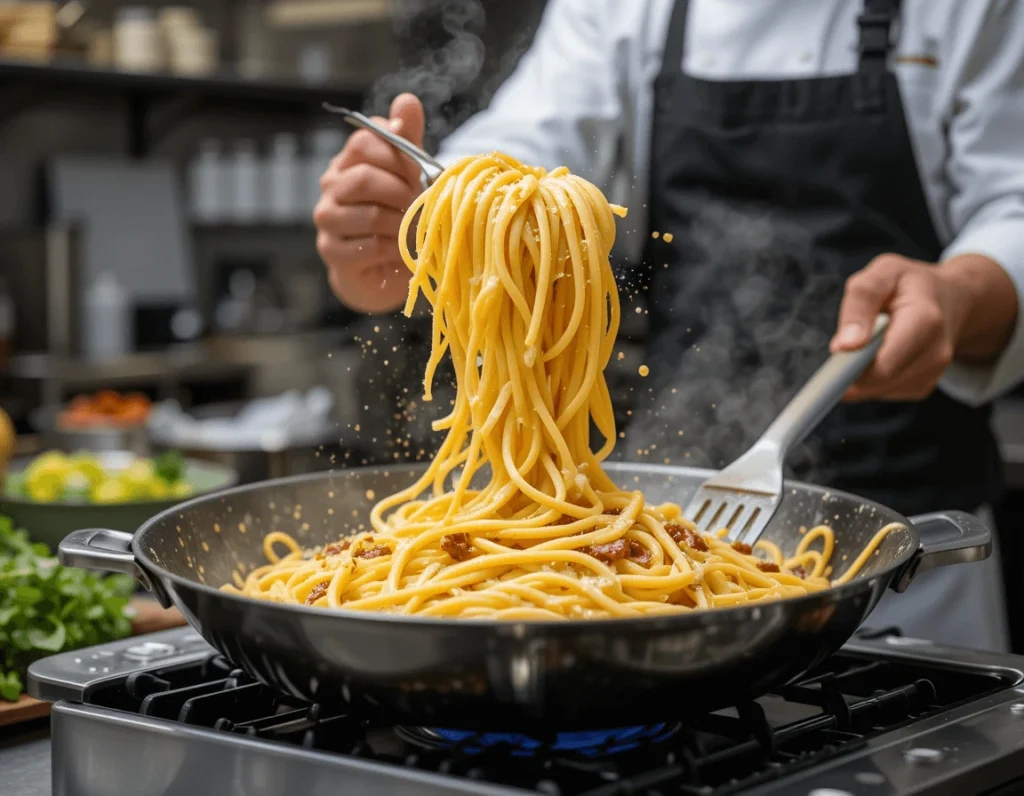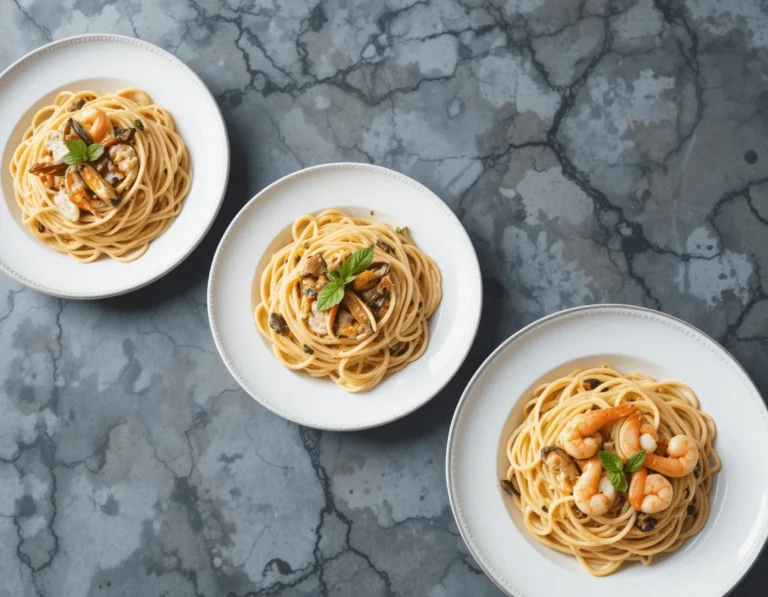Introduction
Spaghetti Carbonara is a beloved Italian classic known for its creamy texture, rich flavors, and simple ingredients. This dish has captivated food lovers across the world, and in this guide, we’ll explore everything you need to know—from the core ingredients to tips on perfecting the sauce. Whether you’re a first-time cook or a seasoned pasta pro, this guide is for you. By the end, you’ll be able to create an authentic and delicious Spaghetti Carbonara from the comfort of your home.
Learn more about Spaghetti Carbonara recipes and tips from Tasty Food Inc..
What Is Spaghetti Carbonara?
Spaghetti Carbonara is a classic Italian pasta dish that originated in Rome. It’s known for its creamy, egg-based sauce and crispy guanciale or pancetta. Despite being simple, the flavor profile is rich, thanks to the perfect combination of eggs, cheese, and cured pork. Let’s take a deeper dive into its origins and the traditional way to prepare it.
The Origins of Spaghetti Carbonara
- Rome, Italy: Carbonara was likely created in the mid-20th century, with some stories linking it to American soldiers in post-World War II Italy. The dish became popular due to the availability of ingredients such as eggs and bacon, which were staples during that time.
The Traditional Recipe of Spaghetti Carbonara
The authentic Spaghetti Carbonara recipe consists of just a few key ingredients:
- Pasta (typically spaghetti)
- Guanciale (Italian cured pork cheek)
- Eggs (fresh, large eggs)
- Pecorino Romano cheese (a hard, salty cheese)
- Black pepper
This combination creates a creamy, velvety sauce that coats the pasta perfectly without using any cream or milk.
Table of Contents
Table of Contents

What Are the Ingredients in Spaghetti Carbonara?
Understanding the ingredients is essential to mastering the art of Carbonara. Here are the key elements that make this dish stand out.
| Ingredient | Description |
|---|---|
| Spaghetti | The most common pasta choice, though fettuccine, rigatoni, or bucatini can also be used. |
| Guanciale | An Italian cured meat made from pork cheek or jowl, it has a more delicate flavor than pancetta. |
| Eggs | Fresh large eggs create the base of the creamy sauce, providing richness and binding the ingredients together. |
| Pecorino Romano | A tangy, salty cheese made from sheep’s milk, providing the authentic Italian flavor. |
| Black Pepper | Freshly cracked black pepper adds spice and complexity to the creamy sauce. |
The Importance of Guanciale
Guanciale, or Italian cured pork cheek, is the star of Carbonara. Its delicate, fatty flavor is what makes the dish stand out compared to other variations that use pancetta or bacon. Its rich, melt-in-your-mouth texture contributes to the creamy, luxurious sauce.
Why Pecorino Romano is Essential
Pecorino Romano cheese adds saltiness and depth to the dish. Unlike Parmesan, it’s made from sheep’s milk, giving it a sharper, tangier taste. The combination of Pecorino with the eggs creates the perfect creamy texture for the Carbonara sauce.

The 4 Main Ingredients in Carbonara
There are four primary ingredients in a traditional Carbonara recipe that create its creamy and savory flavor. Let’s look at each one in more detail.
Guanciale: The Key Ingredient
Guanciale provides a unique, tender flavor that can’t be replicated by bacon or pancetta. Its richness and subtle sweetness balance the tanginess of the Pecorino Romano cheese, contributing to the luxurious mouthfeel of the dish.
Eggs: The Creamy Base
Eggs are the backbone of the Carbonara sauce. When mixed with Pecorino Romano cheese, the eggs form a smooth, creamy texture. The heat from the pasta helps cook the eggs, ensuring that the sauce has a velvety consistency.
Pecorino Romano: The Rich Cheese
This Italian cheese has a sharp, tangy flavor that complements the eggs and pork in Carbonara. It’s essential for creating the balance between creaminess and saltiness.
Black Pepper: A Must-Have for Carbonara
Freshly cracked black pepper is a non-negotiable ingredient. It adds heat and spiciness, which contrasts nicely with the richness of the eggs and guanciale.
What Are the 5 Ingredients in Carbonara?
While the four primary ingredients (guanciale, eggs, Pecorino Romano, and black pepper) are essential, some recipes include additional ingredients to tweak the flavor or texture. Here’s a breakdown of the 5 main ingredients used in Carbonara recipes.
| Ingredient | Role in the Dish |
|---|---|
| Guanciale | Provides rich flavor and tenderness with a melt-in-your-mouth texture. |
| Eggs | The creamy base of the sauce. |
| Pecorino Romano | Adds a sharp, salty flavor to balance the richness of the dish. |
| Black Pepper | Provides heat and spice, enhancing the flavors. |
| Salt | Enhances the natural flavors of the ingredients, though it’s used sparingly. |

What Is Carbonara Sauce Made Of?
Unlike many pasta sauces, Carbonara sauce is made without cream. Instead, it uses a simple combination of eggs, Pecorino Romano cheese, and black pepper. This mixture is tossed with hot pasta and guanciale to create a smooth, velvety sauce.
Making the Sauce
- Eggs: Whisk the eggs and cheese together until smooth and creamy.
- Guanciale: Fry the guanciale until crispy, then combine with the pasta.
- Pasta: Toss the hot pasta with the egg mixture, allowing the heat from the pasta to cook the eggs and create the sauce.
No cream is needed; the egg and cheese mixture forms a luscious, silky sauce that coats the pasta perfectly.

How to Make the Perfect Spaghetti Carbonara?
Making a perfect Spaghetti Carbonara requires attention to detail, especially when it comes to the timing and the order of steps. Here’s a step-by-step guide to making the ultimate Carbonara.
Step-by-Step Guide
- Cook the Pasta: Boil a large pot of salted water and cook your spaghetti according to the package instructions. Reserve some pasta water before draining.
- Prepare the Guanciale: Slice the guanciale into small cubes and fry it in a pan until crispy. Remove from heat.
- Prepare the Egg Mixture: In a bowl, whisk together the eggs, Pecorino Romano, and freshly cracked black pepper until smooth.
- Toss the Pasta: Add the hot, drained pasta to the pan with the guanciale, and toss. Then, pour in the egg mixture and toss again to create the creamy sauce.
- Adjust the Sauce: Add reserved pasta water a little at a time to achieve the desired consistency.
Common Mistakes to Avoid
- Overcooking the eggs: Be careful not to scramble the eggs when adding them to the hot pasta.
- Using too much cream: Traditional Carbonara doesn’t contain any cream, so stick to eggs and cheese for the creamy texture.
Spaghetti Carbonara Variations
While the traditional Spaghetti Carbonara is a culinary classic, its simplicity and versatility have inspired countless variations around the world. From adapting the meat choice to tweaking the type of pasta or adding unique flavors, Spaghetti Carbonara offers flexibility without compromising its essence. Here, we explore some of the most popular and creative variations you can try to make this dish your own.
1. Classic Spaghetti Carbonara (The Traditional Roman Version)
Let’s start with the foundation. The classic Spaghetti Carbonara uses only the most traditional ingredients: guanciale (cured pork cheek), Pecorino Romano cheese, fresh eggs, spaghetti, and black pepper. This version relies on the high-quality guanciale for its distinct flavor, which gives the dish its richness and depth.
Key characteristics of the traditional version:
- Guanciale as the primary meat: The rich, fatty pork adds an unparalleled flavor and texture that pancetta or bacon cannot replicate.
- Pecorino Romano: The sharp, salty cheese from sheep’s milk is essential for achieving the authentic taste.
- Eggs: The eggs form the creamy sauce that binds everything together.
For the most authentic experience, stick to the classic approach and embrace the delicate balance of flavors.
2. Bacon or Pancetta Carbonara
Not everyone has access to guanciale, especially outside of Italy, but the good news is that bacon or pancetta can serve as excellent substitutes. These variations are commonly found in many parts of the world, especially in the United States and the UK.
Key differences:
- Bacon: While it’s not as fatty or tender as guanciale, bacon can still provide that crispy texture and smoky flavor that complements the creamy egg sauce.
- Pancetta: A slightly milder flavor than bacon, pancetta is a great option, though it lacks the same depth of flavor as guanciale.
Though not traditional, these variations allow you to enjoy a delicious version of Carbonara that still retains much of the essence of the original.
3. Vegetarian Carbonara
For those who prefer a meatless option or simply want to experiment with a plant-based dish, a vegetarian Carbonara can be just as satisfying. The rich, creamy sauce can be made without the guanciale, and you can substitute the pork with vegetables that add depth and texture.
Vegetarian substitutions:
- Mushrooms: Roasted or sautéed mushrooms, especially earthy varieties like cremini or portobello, can replicate the rich, savory taste of guanciale. They also add a meaty texture that mimics the original dish.
- Tofu or Tempeh: For a protein-rich option, try crumbled tofu or tempeh. When sautéed, these ingredients can provide a satisfying, chewy texture.
- Peas or Asparagus: Adding a touch of green like peas or asparagus provides a fresh contrast to the rich sauce and adds a layer of texture.
This version can be enjoyed by vegetarians and non-vegetarians alike, offering a lighter yet still indulgent take on the classic.
4. Carbonara with Cream
While traditional Spaghetti Carbonara does not contain cream (the creaminess comes from the eggs), some variations incorporate cream for a richer, more indulgent version. This is especially popular in countries outside of Italy, where the creamy consistency is often a desired feature.
Why add cream?
- Texture: Cream makes the sauce smoother and silkier, which some may prefer, especially if they’re not used to the more subtle egg-based sauce.
- Milder Flavor: For those who find the traditional Carbonara too strong in flavor, the cream can balance out the sharpness of Pecorino Romano.
While purists might argue that adding cream changes the essence of the dish, it still makes for a delicious alternative.
5. Gluten-Free Carbonara
For those with gluten sensitivities or preferences, you can easily turn Spaghetti Carbonara into a gluten-free dish by substituting regular pasta with gluten-free pasta options.
Popular gluten-free pasta options:
- Rice pasta: A common choice, rice pasta is a great gluten-free alternative that doesn’t overpower the flavors of the Carbonara sauce.
- Corn pasta: This option offers a slightly firmer texture and a more substantial bite, making it a great choice for hearty dishes like Carbonara.
- Chickpea pasta: Made from chickpea flour, this option is rich in protein and has a nutty flavor that complements the rich Carbonara sauce.
Using gluten-free pasta ensures that anyone with dietary restrictions can still enjoy the creamy goodness of Carbonara without compromise.
6. Carbonara with Different Cheeses
While Pecorino Romano is the traditional choice for Carbonara, there are many other cheeses that can offer different flavor profiles for a unique twist.
Alternatives to Pecorino Romano:
- Parmesan: A milder, less salty alternative to Pecorino Romano. If you prefer a softer, creamier taste, Parmesan can be a great option.
- Grana Padano: Another Italian cheese that is similar to Parmesan but slightly less sharp and more delicate.
- Aged Manchego: For a Spanish twist, Manchego offers a nutty, buttery flavor that complements the rich sauce.
Mixing Pecorino Romano with these cheeses can also create a harmonious balance of flavors, elevating your Carbonara to new heights.
7. Seafood Carbonara
For a completely different spin on the classic, seafood Carbonara introduces fresh fish or shellfish into the dish. While not an authentic Italian variation, it has gained popularity in coastal regions where seafood is abundant.
Seafood options to try:
- Shrimp: Lightly sautéed shrimp adds a seafood flavor that blends well with the creamy sauce.
- Lobster: For a luxurious version, lobster can add both flavor and elegance to the dish.
- Clams or Mussels: For a more traditional seafood touch, clams or mussels offer a briny, oceanic flavor that works beautifully with the richness of the Carbonara sauce.
These variations are perfect for those who want to explore the depth of flavors that seafood can bring to a classic pasta dish.
8. Carbonara with Truffle
For those looking to add a touch of luxury, truffle-infused Carbonara is an indulgent variation. Truffle oil or shaved truffles can be added to the dish to elevate the richness of the sauce, adding an earthy, aromatic flavor.
How to incorporate truffle:
- Truffle oil: Drizzle a small amount of high-quality truffle oil over the pasta after it’s plated for an aromatic, flavorful boost.
- Shaved truffles: If you’re feeling extravagant, freshly shaved truffles can be used to garnish the dish, offering a luxurious and earthy taste.
This version is perfect for special occasions or for impressing guests with something truly unique.
Spaghetti Carbonara is a dish that can be endlessly adapted to suit different tastes and dietary needs. Whether you’re sticking to tradition with guanciale and Pecorino Romano, going for a vegetarian version, or trying something completely different like seafood or truffle Carbonara, there’s a variation for everyone. The beauty of this dish lies in its simplicity and versatility, making it a timeless favorite in kitchens around the world. Don’t be afraid to experiment with these variations to find your own perfect Carbonara recipe.
Common Mistakes to Avoid When Making Carbonara
Making Spaghetti Carbonara might seem like a simple task, but like many classic dishes, it requires precision and attention to detail to achieve the perfect combination of flavors and texture. Despite the minimal list of ingredients, the cooking process demands a careful balance of heat and timing. Even the smallest mistake can result in a less-than-perfect dish. Understanding the nuances of Spaghetti Carbonara is key to mastering it and ensuring that the pasta is creamy, the sauce is velvety, and the flavors are spot-on.
While many people focus on the ingredients—guanciale, Pecorino Romano, eggs, and spaghetti—the magic happens in how they’re combined. The beauty of Spaghetti Carbonara lies in its simplicity, but this simplicity means that every step counts. Let’s explore the most common mistakes to avoid when making Carbonara so you can serve up a creamy, flavorful bowl of pasta every time.
1. Overcooking the Eggs
One of the biggest mistakes when making Carbonara is overcooking the eggs. Traditional Carbonara doesn’t use cream—it’s the eggs that create the creamy sauce. However, if the eggs are cooked too much, they will turn into scrambled eggs instead of a silky sauce. To avoid this, it’s crucial to mix the hot pasta with the egg and cheese mixture off the heat, letting the pasta’s residual warmth cook the eggs gently. Always work quickly to ensure the eggs don’t curdle.
2. Using the Wrong Type of Pasta
While spaghetti is the most common pasta used in Carbonara, some cooks mistakenly choose the wrong type of pasta that doesn’t properly hold the sauce. Although traditional spaghetti works best due to its long, thin strands, you can also use other long pasta like fettuccine, bucatini, or linguine. The key is to choose a pasta that will help the sauce cling to it. Avoid using short pasta like penne or fusilli, as they don’t allow the creamy Carbonara sauce to coat the pasta evenly.
3. Not Using Guanciale
Guanciale is the traditional cured meat used in Spaghetti Carbonara, and it’s what gives the dish its authentic flavor. Many people try to substitute it with bacon or pancetta, but this often results in a less rich and flavorful Carbonara. While pancetta can be an acceptable alternative in a pinch, guanciale provides a unique depth of flavor and fat content that bacon or pancetta can’t replicate. If you can, always choose guanciale for the most authentic Carbonara.
4. Skipping the Pasta Water
Pasta water is one of the most underrated ingredients when making Carbonara. The starchy water helps to thin out the egg mixture and create the perfect creamy consistency for the sauce. It also helps the sauce adhere to the pasta more smoothly. When draining your pasta, always save some of the cooking water. Then, slowly add it to the egg mixture, a little at a time, until you achieve the desired sauce consistency. Without pasta water, you may end up with a clumpy or too-thick sauce.
5. Using Pre-grated Cheese
While it might be tempting to grab a bag of pre-grated Pecorino Romano from the supermarket, fresh cheese is always the better choice for Carbonara. Pre-grated cheese often contains anti-caking agents, which can affect the texture of the sauce. For the best results, use a block of Pecorino Romano and grate it yourself. The freshly grated cheese will melt better into the sauce and provide a smoother, creamier texture.
6. Not Tossing the Pasta and Egg Mixture Quickly Enough
Carbonara is all about timing. After the pasta is drained, you must toss it immediately with the egg and cheese mixture. This allows the heat from the pasta to cook the eggs without scrambling them. If you wait too long to toss, the pasta will cool down too much, and the sauce won’t come together properly. Toss the pasta with the egg mixture quickly and thoroughly to ensure that every strand is coated in the creamy sauce.
7. Not Seasoning Properly
While Pecorino Romano and guanciale are naturally salty, it’s important to taste the dish before serving and adjust the seasoning if necessary. If you don’t add enough salt to the pasta water, the entire dish may lack flavor. Additionally, always use freshly cracked black pepper, as it brings a vibrant kick to the Carbonara. Too little pepper can leave the dish flat, while too much can overpower the other flavors.
8. Adding Cream to the Sauce
One of the biggest modern deviations from traditional Carbonara is the addition of cream. While many versions of Carbonara seen in restaurants and on the internet include cream, this is not part of the classic recipe. The richness of the sauce comes entirely from the eggs, cheese, and guanciale fat. Adding cream results in a dish that is too heavy and doesn’t have the same smooth, silky consistency that the egg-based sauce creates. Stick to the traditional method and keep your Carbonara cream-free for the best results.
9. Overcrowding the Pan
When cooking the guanciale, it’s important to avoid overcrowding the pan. If you add too much guanciale at once, it won’t fry properly and may release too much fat, making the dish greasy. Cook the guanciale in small batches to ensure it crisps up nicely. The fat from the guanciale should then be used to coat the pasta, adding richness to the sauce.
10. Forgetting to Let the Pasta Rest
Once your Carbonara is prepared, let it rest for a minute or two before serving. This allows the sauce to set and thicken, making it even creamier. If you serve it immediately after mixing, the sauce might be too runny. Allowing the pasta to sit for just a minute helps achieve that perfect creamy consistency.
Pro Tips for Perfect Carbonara
- Use a pasta spoon to toss the pasta and ensure that the sauce is evenly distributed.
- Serve immediately: Carbonara is best enjoyed fresh, right after it’s made. Reheating it can cause the sauce to break or become clumpy.
- Don’t skimp on the cheese: The cheese is what gives the Carbonara its distinct flavor, so be generous with it!
By avoiding these common mistakes and following the tips for success, you’ll be able to make the perfect Spaghetti Carbonara every time. Remember, the beauty of Carbonara lies in its simplicity, and with a little practice, you can master this classic Italian dish that’s sure to impress your family and friends.
Frequently Asked Questions About Spaghetti Carbonara
What Are the Ingredients in Spaghetti Carbonara?
The main ingredients in Spaghetti Carbonara are spaghetti, guanciale, eggs, Pecorino Romano cheese, and black pepper.
Can I Make Carbonara Without Guanciale?
Yes! You can use pancetta or bacon as substitutes, but the flavor and texture will be different.
Can I Make a Lighter Version of Carbonara?
You can make a lighter version by using fewer eggs and substituting part of the guanciale with a leaner meat or plant-based alternative.
Conclusion:
Spaghetti Carbonara is more than just a dish—it’s a symbol of the elegance and simplicity inherent in traditional Italian cuisine. With its roots deeply embedded in the heart of Rome, Spaghetti Carbonara has stood the test of time due to its balanced combination of creamy textures, salty cured meat, and rich, savory flavors. Whether you’re preparing Spaghetti Carbonara using the authentic ingredients of guanciale, Pecorino Romano, and eggs, or you’re experimenting with modern twists and variations, this dish offers endless possibilities to explore in your kitchen.
Mastering Spaghetti Carbonara is not only about following a recipe but about understanding the soul of Italian cooking—using fresh, high-quality ingredients and letting them speak for themselves. By adhering to the traditional methods or embracing some creativity, you can easily recreate this comforting Spaghetti Carbonara meal in your own home.
With its quick preparation, ease of making, and indulgent taste, Spaghetti Carbonara remains a beloved comfort food that continues to bring families together over a deliciously satisfying meal. Whether you’re serving Spaghetti Carbonara at a family dinner, a special occasion, or simply for a weeknight meal, this dish is sure to impress.
So, next time you’re craving a classic Italian dish, why not bring the flavors of Rome straight to your table with Spaghetti Carbonara? Don’t forget to experiment, share the joy, and most importantly—enjoy the creamy, savory, and rich indulgence that is Spaghetti Carbonara with your loved ones. Buon appetito!
Print
The Ultimate Guide to Spaghetti Carbonara: Ingredients, Recipe, and Secrets to Perfection
Description:
Spaghetti Carbonara is a traditional Italian pasta dish made with a rich and creamy sauce. It’s made with fresh eggs, Pecorino Romano cheese, crispy guanciale, and freshly cracked black pepper. This iconic Roman recipe is a deliciously simple yet flavorful comfort food that will impress at any meal. Perfect for a quick weeknight dinner or a special occasion.
- Total Time: 25 minutes
- Yield: 2 servings 1x
Ingredients
200g (7oz) spaghetti
100g (3.5oz) guanciale (or pancetta, if unavailable)
2 large eggs
50g (1.75oz) Pecorino Romano cheese (grated)
1 tablespoon freshly cracked black pepper
Salt (for pasta water)
Instructions
Cook the pasta: Bring a large pot of salted water to a boil. Add the spaghetti and cook according to the package instructions (typically 8-10 minutes) until al dente. Reserve 1/2 cup of pasta water and set aside before draining.
Prepare the guanciale: While the pasta is cooking, slice the guanciale into small strips or cubes. Heat a skillet over medium heat and cook the guanciale until crispy and golden. Remove from the heat and set aside.
Mix the eggs and cheese: In a mixing bowl, whisk together the eggs, grated Pecorino Romano cheese, and freshly cracked black pepper until well combined. Set aside.
Combine the pasta and guanciale: Add the drained pasta to the skillet with the crispy guanciale (still off the heat). Toss well to coat the pasta with the rendered fat from the guanciale.
Make the creamy sauce: Slowly pour the egg and cheese mixture over the pasta, tossing continuously. Add a little reserved pasta water at a time to achieve a smooth, creamy sauce that coats the pasta. The heat from the pasta will gently cook the eggs, creating the sauce.
Serve: Taste the Carbonara and adjust seasoning with more black pepper or Pecorino Romano. Serve immediately, garnished with extra cheese if desired.
Notes
Guanciale is the traditional meat used for Spaghetti Carbonara. If unavailable, pancetta can be used as a substitute, but it will alter the flavor slightly.
Make sure the pasta is hot when you combine it with the egg mixture to ensure the eggs cook just enough to create the creamy sauce.
Don’t add cream! Traditional Spaghetti Carbonara relies only on eggs and cheese to make the sauce creamy.
- Prep Time: 10 minutes
- Cook Time: 15 minutes
- Category: Pasta
- Method: Stovetop
- Cuisine: Italian
Nutrition
- Serving Size: 1 serving (half of the total recipe)
- Calories: 650 kcal
- Sugar: 2g
- Sodium: 900mg
- Fat: 28g
- Saturated Fat: 8g
- Unsaturated Fat: 12g
- Trans Fat: 0g
- Carbohydrates: 70g
- Fiber: 3g
- Protein: 23g
- Cholesterol: 220mg
Keywords: Spaghetti Carbonara Traditional Carbonara Roman pasta recipe Italian pasta Guanciale pasta


